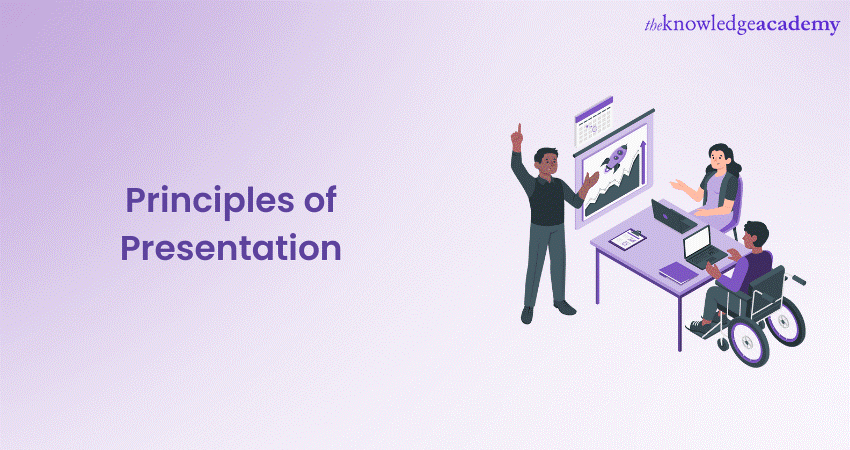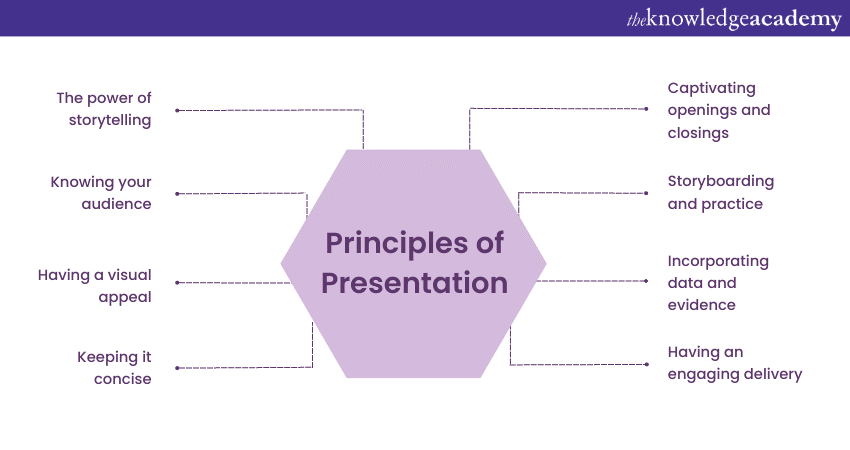We may not have the course you’re looking for. If you enquire or give us a call on 01344203999 and speak to our training experts, we may still be able to help with your training requirements.
Training Outcomes Within Your Budget!
We ensure quality, budget-alignment, and timely delivery by our expert instructors.

Presentations have become an essential tool for effectively communicating ideas, information, and concepts in the digital era. Therefore, it’s crucial to understanding the Principles of Presentation is crucial for developing Presentation Skills and delivering impactful messages.
Whether you are a student, a professional, or an entrepreneur, understanding these rules can help you enhance your overall Presentation style. In this blog, we will delve into the Principles of Presentation and equip you with the knowledge to create content that captivates your audience.
Table of Contents
1) What are the Principles of Presentation?
a) The power of storytelling
b) Knowing your audience
c) Having a visual appeal
d) Keeping it concise
e) Having an engaging delivery
f) Incorporating data and evidence
g) Storyboarding and practice
2) Conclusion
What are the Principles of Presentation?
In this section of the blog, we will delve into the fundamental principles of a compelling Presentation:

The power of storytelling
Storytelling is an ancient art form that has stood the test of time. Stories, from ancient legends to modern-day movies and books, have always captivated human minds. When it comes to Presentations, the power of storytelling lies in its ability to develop an emotional connection with the audience. You can also understand by principles of presentations by going through presentation skills interview questions and answers.
People remember stories much better than dry facts and figures. When you prepare a presentation, consider weaving your content into a narrative to make it more relatable, memorable, and engaging. By sharing anecdotes, personal experiences, or even fictional scenarios, you can illustrate your points effectively and leave a lasting impression on your listeners.
Knowing your audience
Understanding your audience is a cornerstone of successful Presentations. Tailoring your content to your audience's needs, interests, and preferences ensures that your message resonates deeply with them.
Start Your Presentation by identifying who your audience is. Are they students, colleagues, potential customers, or a mix of individuals from different backgrounds? Understanding their demographics and their prior knowledge of the topic will help you gauge the level of detail and complexity your Presentation should have.
Once you've identified your audience, dig deeper to discover their pain points or challenges. Ask questions like, what issues are they facing that your Presentation can help address? By addressing these pain points and providing solutions, you show your audience that you value their concerns and are here to help.
Unlock your full potential as a presenter with our Presentation Skills Training – join now!
Having a visual appeal
In a society brimming with information, visual elements play an ever-essential role in keeping your audience engaged and focused on your Presentation. Enhance your Presentation with relevant images, infographics, charts, and videos. Visuals break the monotony of text-heavy slides and stimulate the audience's visual senses, making your content more memorable.
Also, take care to ensure that your visual design is consistent throughout the Presentation. Use the same colour palette, font styles, and layout. A cluttered slide can be overwhelming, so keep it simple, ensuring that each element supports your message without distracting you from it.
Keeping it concise
Attention spans are limited in the modern, fast-paced society. Keeping your Presentation concise and to the point is essential to maintain your audience's interest.
Respect your audience's time by focusing on the core message and key takeaways. Avoid going off-topic or getting bogged down in unnecessary details. Take care to organise your content with clear and concise bullet points. Bullet points break down information into smaller chunks, making it easier for your audience to absorb the main ideas.
Having an engaging delivery
A compelling Presentation not only depends on the content but also on how you deliver it. Your delivery style can influence your audience's level of engagement and interest.
Confidence is key when presenting. Practice your Presentation multiple times to familiarise yourself with the content and overcome nervousness. Work on your body language, voice modulation, and eye contact to keep your audience connected. Understanding various elements of presentation becomes crucial.
You can also encourage audience participation by incorporating questions, polls, or interactive activities. Engaging your audience in this way creates a dynamic and lively atmosphere, making the Presentation more enjoyable and memorable.
Take your Presentations to the next level with our Effective Presentation Skills & Techniques Course – sign up today!
Incorporating data and evidence
Supporting your arguments with data and evidence adds credibility to your Presentation and makes your points more convincing. Whether it's statistical data, research findings, or case studies, using relevant data provides a solid foundation for your arguments. Your audience is more likely to trust and retain information when credible sources back it.
Moreover, presenting statistics in visually appealing ways, such as graphs, charts, or diagrams, makes complex information easier to understand. Visualisations allow your audience to grasp patterns and trends, reinforcing key points quickly.

Storyboarding and practice
One of the crucial Principles of Presentation is storyboarding and practice. Behind every successful Presentation is careful planning and practice. Storyboarding helps you organise your content effectively, while practice ensures a smooth and confident delivery.
To practice storyboarding, create a detailed storyboard that outlines the structure of your Presentation, including the main points, supporting evidence, and visual elements. A well-structured storyboard serves as your roadmap, ensuring that you cover all essential aspects of your topic.
Make sure to practice delivering your Presentation in front of a mirror, friends, or family. Pay attention to timing, pace, and transitions between sections. Moreover, rehearsing will help you identify areas for improvement and build your confidence.
Captivating openings and closings
The first and last moments of your Presentation are crucial for making a strong impact on your audience. Start your Presentation with a hook – a thought-provoking question, a surprising fact, or a compelling story. An engaging opening captures the audience's attention from the beginning, setting the tone for the rest of the Presentation. It becomes important to understand that advantages and disadvantages of presentation to build captivating openings and closings.
You must also make sure that you end your Presentation with a memorable closing statement or a powerful call to action. Leave your audience with a clear takeaway or a next step they can follow after the Presentation. A strong closing ensures that your message lingers in their minds long after the Presentation is over.
Conclusion
Overall, mastering the Principles of Presentation is an invaluable skill that can elevate your communication abilities to new heights. By storytelling, knowing your audience, utilising visuals, delivering engagingly and supporting your points with data, you can Improve Your Presentation Skills to create impactful and appealing presentations that leave a lasting impression.
Want to master the art of impactful Presentations? Explore our Presentation Skills Courses and elevate your communication prowess!
Frequently Asked Questions
Upcoming Business Skills Resources Batches & Dates
Date
 Presentation Skills Training
Presentation Skills Training
Fri 7th Jun 2024
Fri 5th Jul 2024
Fri 2nd Aug 2024
Fri 6th Sep 2024
Fri 4th Oct 2024
Fri 1st Nov 2024
Fri 6th Dec 2024







 Top Rated Course
Top Rated Course


 If you wish to make any changes to your course, please
If you wish to make any changes to your course, please


